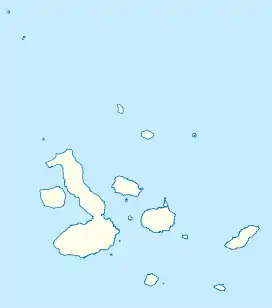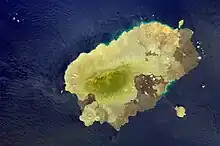 Santiago Island | |
| Geography | |
|---|---|
| Location | Galápagos Islands, Ecuador |
| Coordinates | 0°15′09″S 90°43′05″W / 0.252364°S 90.717952°W |
| Archipelago | Galápagos Islands |
| Highest elevation | 906 m (2972 ft) |
| Highest point | Cerro Pelado |
| Administration | |
| Demographics | |
| Population | 0 |

_topographic_map-en.png.webp)
Santiago Island is one of the Galápagos Islands. The island, which consists of two overlapping volcanoes, has an area of 585 square kilometers (226 sq mi) and a maximum altitude of 907 meters (2,976 ft), atop the northwestern shield volcano. The volcano in the island's southeast erupted along a linear fissure and is much lower. The oldest lava flows on the island date back to 750,000 years ago.
Names
The original Spanish name was San Marcos Island[1] (Isla or Ysla San Marcos),[2] honoring Saint Mark the Evangelist. In 1892, as part of Ecuador's celebration of the quadricentennial of Columbus's first voyage, it was renamed Salvador or San Salvador Island (Isla San Salvador) after the first island Columbus reached. Isabela and Fernandina were similarly renamed for the third and fourth islands. The present name Santiago ([sanˈtjaɣo]) is the Spanish name of Saint James and a major center of pilgrimage in northern Spain.
In English, the island has also been known as Duke of York's Island,[3] King James's Island,[4] and James Island, all in honor of King James II of England.[3] The name was originally bestowed by the pirate William Ambrosia Cowley in 1684 and altered in 1685 after James's coronation.[3] Cowley had similarly named Floreana Island King Charles's Island after Charles II.[3]
Geology
Santiago Island is one of the islands in the Galapagos Archipelago.[5] It was formed from a shield volcano eponymously named Santiago.[6] The oldest lava flows on the island date back to 750,000 years ago.[7] The low, flat summits of the volcano allowed the low-viscosity lava to flow for large distances from the source vents.[8] The volcanic origin of the island has led it to be dotted with holocene pyroclastic rock that can be found across the island.[9] On the eastern and western sides of the island, tuff cones, formed from the rapid interaction of hot lava and water, are visible.[10] The summit of the volcano is on the northwestern part of the island and the last recorded volcanic activity on Santiago Island was between 1904 and 1906.[11]
Wildlife
Like the other islands of the Galápagos archipelago, Santiago Island is rife with wildlife, particularly species endemic to the Galápagos. Some animals commonly seen on the island include the Galápagos fur seal, Galápagos sea lion, Sally Lightfoot crab, marine iguana and Galápagos land iguana, bottlenose dolphin, rice rat, and Microlophus.[12] Charles Darwin in October 1835 noted that the island's population of land iguanas was immense: "I cannot give a more forcible proof of their numbers than by stating that when we were left at James Island we could not for some time find a spot free from their burrows on which to pitch our single tent."[13] On the plants and vegetation, Darwin observed, "As in the other islands, the lower region was covered by nearly leafless bushes, but the trees were here of larger growth than elsewhere. The upper region, being kept damp by the clouds, supports a green and flourishing vegetation."[14]
Restoration
The Directorate of Galápagos National Park and Island Conservation reintroduced 1,436 Galápagos Land Iguanas (Conolophus subcristatus) to Santiago Island on 4 January 2019 after a 180-year absence. The partners reintroduced the land iguanas in an effort to restore the island's ecological health and to provide the opportunity for this iguana species to thrive. Land iguanas were sourced from North Seymour Island, where they were introduced in the 1930s and have increased to over 5,000 and faced a lack of food availability. Charles Darwin was the second-last person to record land iguanas alive on Santiago Island in 1835, with Abel-Nicolas Bergasse du Petit-Thouars being the last in 1838.[15][16][17][18][19][20] [21]
Gallery
 Tuff cone on the east side of the island
Tuff cone on the east side of the island Cracked hardened lava flow on the island
Cracked hardened lava flow on the island Panorama of the east side (Note the older sand & vegetation in the background and newer hardened lava in the foreground)
Panorama of the east side (Note the older sand & vegetation in the background and newer hardened lava in the foreground) Land Iguana basking in the sun
Land Iguana basking in the sun Galápagos Sea Lion napping between hardened lava formations
Galápagos Sea Lion napping between hardened lava formations Sally Lightfoot Crab (Grapsus Grapsus) on Santiago
Sally Lightfoot Crab (Grapsus Grapsus) on Santiago
See also
References
Citations
- ↑ Kitchin, Thomas (1797), "South America", Kitchin's General Atlas..., London: Laurie & Whittle.
- ↑ De la Fuente, Vicente (1744), Nueva y Correcta Carta del Mar Pacifico ó del Sur... [New and Improved Map of the Pacific or Southern Sea] (in Spanish), Madrid.
- 1 2 3 4 McEwen (1988), p. 237.
- ↑ McEwen (1988), p. 235.
- ↑ "Santiago". Galapagos Conservancy. galapagos.org. Retrieved 6 June 2017.
- ↑ "Santiago Volcano". Volcano Discovery. Retrieved 14 July 2021.
- ↑ "Santiago". Galapagos Geology on the Web. Cornell University. Retrieved 28 April 2021.
- ↑ Swanson, Frederick (1 November 1974). "Geology of Santiago, Rábida, and Pinzón Islands, Galápagos". Geological Society of America Bulletin. 154 (11): 1803–1810. doi:10.1130/0016-7606(1974)85<1803:GOSRAP>2.0.CO;2. Retrieved 14 July 2021.
- ↑ "Santiago". Smithsonian Institution Museum of Natural History Global Volcanism Program. Retrieved 14 July 2021.
- ↑ "Types of Volcanos: Splatter and Tuff Cones". Freie Universität Berlin Department of Earth Science. Retrieved 14 July 2021.
- ↑ "Isla Santiago, Galapagos Islands". NASA Earth Observatory. Retrieved 14 July 2021.
- ↑ "Santiago Island, Galapagos". Galapagos Insiders. Retrieved 14 July 2021.
- ↑ "The Voyage of the Beagle". The University of Pennsylvania. Retrieved 14 July 2021.
- ↑ Hamann, Ole (May 1993). "The Vegetation of Isla Santiago-Past and Present". Noticias de Galapagos. 52: 6–11. Retrieved 14 July 2021.
- ↑ "Threatened Galápagos Land Iguanas Return to Santiago Island En-Masse After 180-Year Absence". Island Conservation. Retrieved 9 January 2019.
- ↑ "Galápagos island gets its first iguanas since Darwin after mass-release". The Guardian. Retrieved 9 January 2019.
- ↑ "Iguanas reintroduced to Galapagos island after 200 years". CNN.com. Retrieved 9 January 2019.
- ↑ "Iguanas Are Being Reintroduced to a Galapagos Island Two Centuries After They Disappeared". TIME. Retrieved 9 January 2019.
- ↑ "Iguanas reintroduced to Galapagos island after almost 200 years". The Independent. Retrieved 9 January 2019.
- ↑ "Iguanas Reintroduced to the Largest Galapagos Island After Nearly 200 Year Absence". Earther. Retrieved 9 January 2019.
- ↑ "Santiago Island Lava fields and wildlife at Puerto Egas". Retrieved 30 January 2021.
Bibliography
- McEwen, Alec (July 1988), "The English Place-Names of the Galápagos", The Geographical Journal, vol. 154, London: Royal Geographical Society, pp. 234–242, doi:10.2307/633849, JSTOR 633849.
External links
![]() Media related to Santiago (Galápagos) at Wikimedia Commons
Media related to Santiago (Galápagos) at Wikimedia Commons